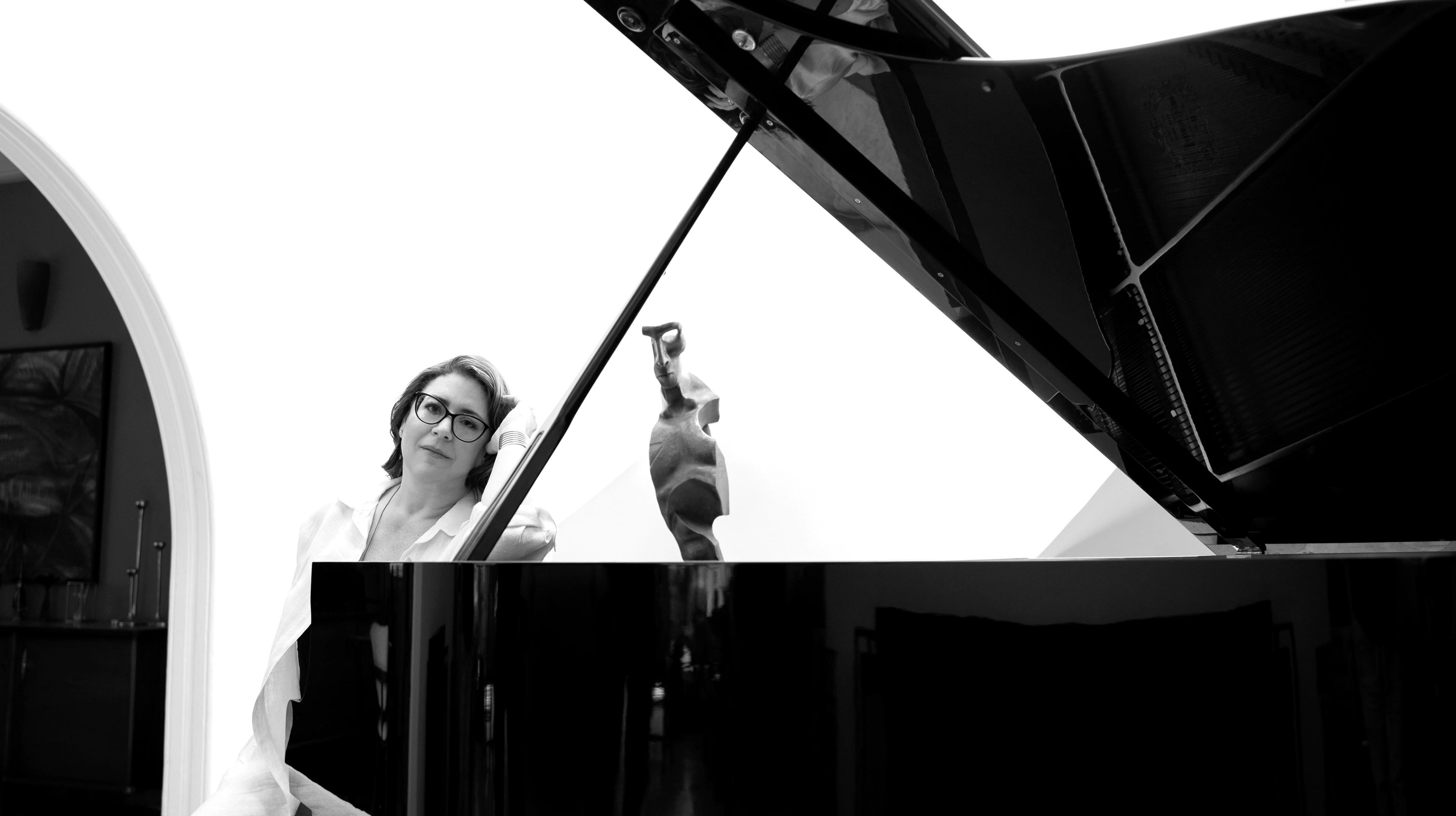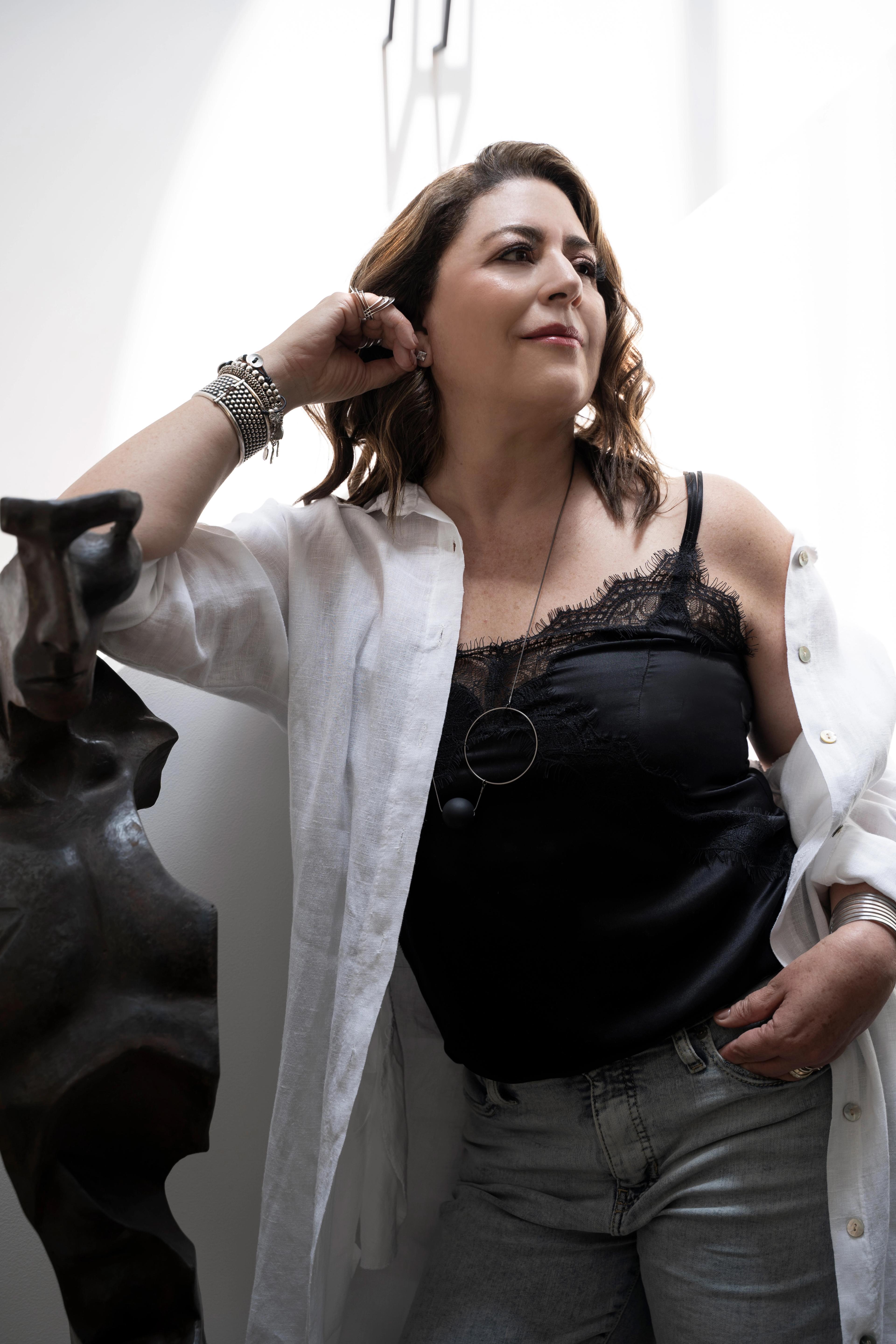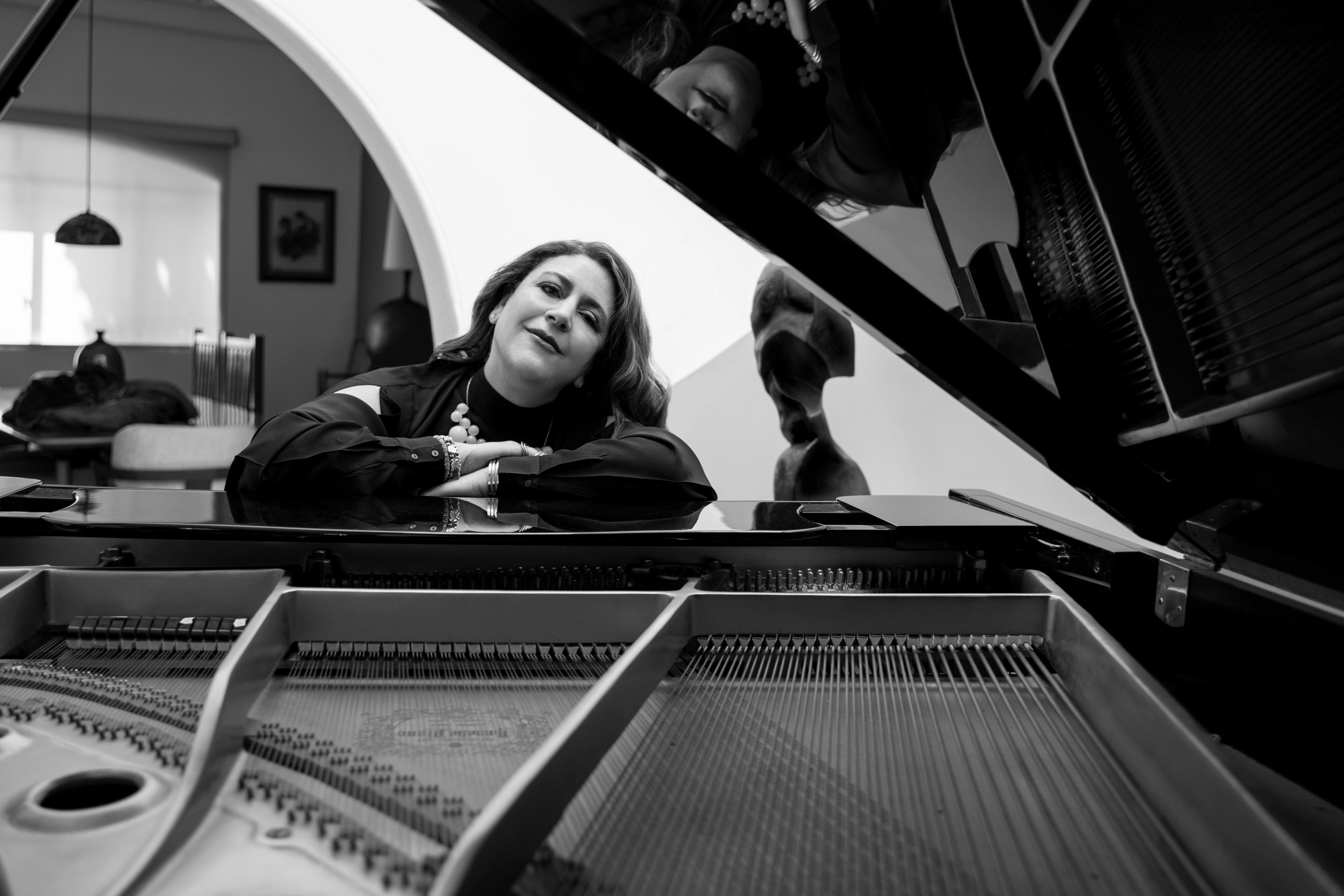Composer Gabriela Ortiz’s vocal work Canta la Piedra—Tetluikan (A Song of the Stone), co-commissioned by The Met and Carnegie Hall for the reopening of The Michael C. Rockefeller Wing, begins with a simple proclamation: atl, or “water” in the Indigenous Mexican language of Nahuatl. Tlitl (“fire”) follows; zokitl (“clay”) and ejekatl (“wind”) complete the four elements. Each sacred substance receives a precise number of repetitions, the “tl” sounds—pronounced almost as explosive, flat-tongued “shhh”s—rippling percussively through the ensemble.
Ortiz sets Canta la Piedra’s text, a new Nahuatl poem by the venerated Mexican writer Mardonio Carballo, with onomatopoeia in mind. Whether instrumental or vocal, her music drives with rhythm and contagious energy, deeply rooted and embodied even at its most complex. This signature sound has earned her laurels as Mexico’s most prominent living composer, with honors including a Guggenheim Fellowship, a yearlong residency at Carnegie Hall, and three Grammy Awards in 2025, including for Best Contemporary Classical Composition.

Composer Gabriela Ortiz.
Ahead of the work’s Met premiere on November 7 with genre-defying vocal ensemble Roomful of Teeth—alongside Ortiz’s powerful Kauyumari and a rare taste of the endangered Mexican canto cardenche tradition with Coro Acardenchado—I caught the composer on a video call from her home in Mexico City. We discussed her inspirations for Canta la Piedra and beyond, her philosophy on music and life, and what she tells the next generation of composers she’s helping to nurture. Our conversation has been condensed and edited for clarity.
Emery Kerekes:
What aspects of The Michael C. Rockefeller Wing’s reopening does Canta la Piedra—Tetluikan celebrate? Do you remember what struck you when you first saw the Ancient Americas galleries? How do visual art and music connect for you?
Gabriela Ortiz:
I had the chance to see the Arts of the Ancient Americas galleries before they were open to the public. I went with curator Laura Filloy Nadal, who is a friend of mine—we studied together in Mexico. Laura explained all the different ideas behind the curation and organization of the new pieces. Since the beginning of the renovation, she had wanted to organize a concert around the reopening.

Nayarit artists (West Mexico). House model, 200 BCE–300 CE. Ceramic, slip, 12 x 8 5/8 x 6 1/8 in. (30.3 x 21.9 x 15.5 cm). The Metropolitan Museum of Art, New York, The Michael C. Rockefeller Memorial Collection, Bequest of Nelson A. Rockefeller, 1979 (1979.206.359)
There was one very small work that described how these ancient people lived; it was made of clay and had little houses. When I saw it, I felt like I had traveled back in time. Laura explained the clothes and the lifestyle, and it was very, very powerful. It made me think about their ceremonies, their cosmogonic point of view. I had been to the National Museum of Anthropology in Mexico City so many times, but I had never seen anything like this before.
We started talking about it, and immediately I felt that the voice would be the best vehicle. The voice is as ancient as the moment that we became humans. It’s what we have attached to our bodies, and that’s something that I felt when I saw the artworks. Those pieces are attached to our souls and our roots, because these ancient cultures existed in America for centuries before the Europeans arrived.
My idea was to create a kind of multifaceted music where poetry, nature, sacred numerology, and ancestral art converge and intertwine.
The voice can create very percussive sounds—but in this case, I wanted to have a text. Laura suggested collaborating with Mardonio Carballo, one of the most important poets in the Nahuatl language. He wrote this beautiful poem around the four elements: earth, water, air, and fire. Those elements have profound and sacred resonance within Mesoamerican cultures, and each element reveals a facet of those peoples’ life and spirit. Earth is a sacred mother that nourishes and sustains life. Water’s flow is a symbol of renewal. Air is the breath of the wind and thought. Fire is the transformative flame of power and creation.
The poem has very specific repetitions of these words in Nahuatl. It was a challenge to set to music, because those repetitions are kind of mantras, rituals, sacred numbers for these people. I decided not to change any single repetition. If it was supposed to be repeated thirteen, twenty, or twenty-three times, I did it. That repetition is more or less the basis for the music.
Music is very abstract, but that doesn't mean you don't feel emotions while seeing these artworks or reading the poem. My idea was to create a kind of multifaceted music where poetry, nature, sacred numerology, and ancestral art converge and intertwine, each enriching the other into a new and diverse sound world.

Kerekes:
You’ve written a fair amount for the voice: songs, operas, choral works. Tell me about your approach. What are some of the unique things that Roomful of Teeth brought to this project?
Ortiz:
I immediately knew that I wanted to write this piece for Roomful of Teeth. They are so versatile—I wanted to get a totally different color from the world of opera and contemporary European classical music, and it seemed to me that Roomful was the perfect group to collaborate with.
The pronunciation of the Nahuatl is not easy. I have a piece that uses Maya text, but this was my first time working with Nahuatl. I tried to use the language and the repetitions to create different rhythmic patterns and melodies that awaken the poetry, the hidden emotions, the sonic landscapes. I imagine a lot of music in my head, and when I write for the voice, I try to sing—I’m a terrible singer. But with the Nahuatl, I didn’t know what the text rhythm was like, and at the beginning, Mardonio’s recordings were all too fast!
We don't know what Aztec music sounds like. We have testimonies of some of these instruments, but there is nothing that we could really know about the music. All we hear in Mexico is a mix between the Europeans and the Indigenous cultures. So I tried to escape from these cliches of Indigenous Mexican music and to be inspired down a different path.
I grew up in Mexico City. I didn't grow up in Berlin. So why do I have to follow the Europeans who say that music should sound like this avant-garde modernism that was created in Europe? I don't belong to that. I belong to this continent, to America.
I use whatever appeals to me—you can get inspiration from anything! People say the rhythm in my music is a feature of Latin American music—but it’s also featured in African music, in flamenco, in Indian music. The question then becomes why you're using all these sources. You have to be very careful about whether everything that you're taking really represents you, while also following your needs as an artist.
Kerekes:
One thing I’ve always admired about your music is the way it engages salient points in history. Your Grammy Award–winning Revolución diamantina, for instance, takes on the 2019 Mexican “glitter revolution” targeting institutionalized violence against women. Tell me your thoughts about responding to history and current events in the classical-music sphere, which sometimes skirts that imperative.
Ortiz:
Mexico is a wonderful country, but we have lots of complications—lots of things that are, ethically speaking, not right. Mexico is a very dangerous place for women. Every day throughout the country, an average of eleven femicides occur. My daughter lives in London now, but when she was eighteen or nineteen years old, it was really unthinkable for her to go out alone at night. I remember the first time she did an exchange program when she was at university in Mexico. She went to Barcelona for a month, and when I asked if she was enjoying the city, the first thing she said to me was: “Mamá, in this city I feel free and safe.”
And so, I wanted to talk about this violence against women. I did it in a piece that’s called Río Bravo, which talks specifically about the femicides that were happening on the border between El Paso, Texas, and Ciudad Juárez, Mexico. But then I was commissioned to write a ballet, and in European music, all the most famous ballets tell stories: Stravinsky’s Rite of Spring, Tchaikovsky’s Swan Lake.
I chose the story of someone who was raped by the police, and the women’s organizations and collectives that spoke out about it. They painted the streets of Mexico City with purple and pink glitter—graffiti on statues, broken windows. It was very polemical, the way they took to the streets, and since then it’s been known as the “glitter revolution.”
I wanted to bring the voice of the streets into the context of the classical-music world, which was very challenging. People ask me why I always talk about Mexico—a lot of these issues happen everywhere, like climate change, for instance. But in Mexico, the cenotes, these beautiful underground rivers, have been contaminated by tourist developments, and those ecosystems supply water for the whole peninsula. Soon, there won’t be any water if they continue. I want to talk about the beauty of these places, which were also sacred to the Mayas. I don’t belong to a scientific organization, so I talk about it through my music.

Kerekes:
You're also an active professor at the National Autonomous University of Mexico (UNAM). In your eyes, what has changed in the classical-music world that you are preparing your students to enter, versus the one for which your teachers prepared you?
Ortiz:
I have been teaching at UNAM for twenty-five years, and you always learn from young people—but especially at a free university like UNAM. I really admire that education is free in my country. It’s hard to get in, but once you do, you don’t pay anything.
In the music faculty, you find students from all different socioeconomic strata. And I've seen students from so many distinctive backgrounds working hard and fighting to become artists. Some are the first in their families to get a diploma, and I've learned so much from their courage. That’s why I decided to live in Mexico, because for me it’s important to contribute to that.
If you come to these incredible institutions in the United States, you have really wonderful musicians and professors, plus the universities have economic resources to invite important musicians and professors from other universities. In Mexico, it’s very difficult. UNAM is enormous, with nearly 350,000 students, and we don’t have those resources. This past summer, however, the composer John Adams came to conduct one of the orchestras in Mexico City. He gave a master class to a full auditorium—1,500 students just listening to John talk about his music. When I see my students getting scholarships to study abroad, I feel extremely proud.
I tell my students to live their lives intensely. Music has the power to communicate experiences—right up to the experience of life itself—and if you don’t experience your life in a profound way, you won’t have the full vocabulary that you need to talk about it. You need to feed that, and the best way to do it is by reading that poem, or going to see your friends, or visiting nature.
You have to be aware of everything that surrounds you, to think deeply about it and to reflect it back into the world. That’s what made Beethoven’s music so strong, and Mahler’s, too. We have the power to talk about these issues, but if you want to talk about it, you really have to reflect your own experience as a human being.
